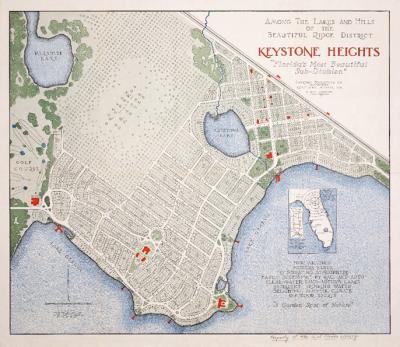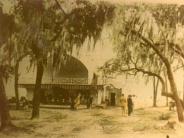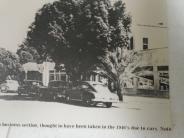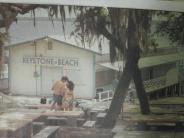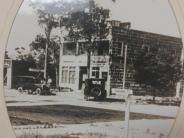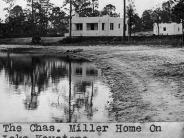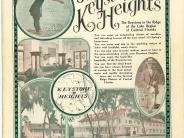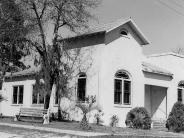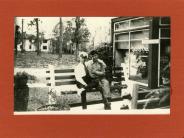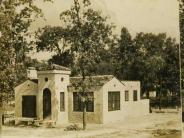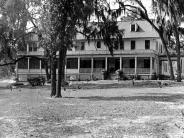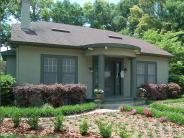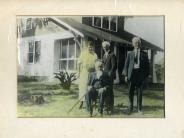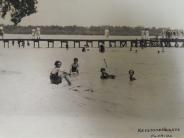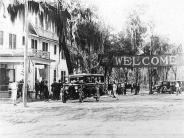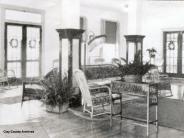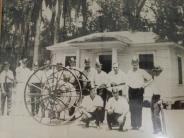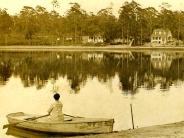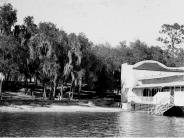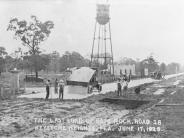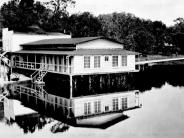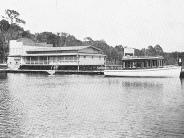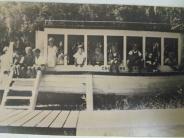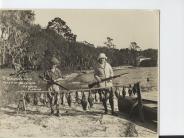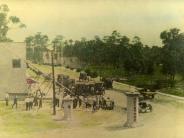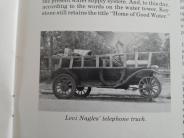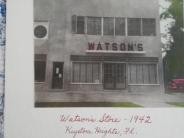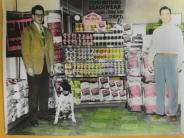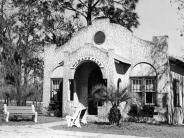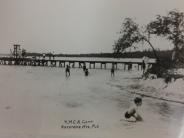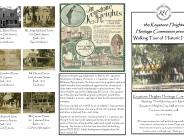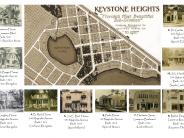About Keystone Heights
The Florida Land Boom of the 1920s attracted John J. Lawrence of Pittsburgh, PA, an ordained minister, to establish a community in the southern Clay County “lake region”. After abandoning plans for real estate development in Miami, Lawrence became active for a time in the development of Sebring, Florida, where he met J. B. Zell, who owned land near Lake Brooklyn in Clay County. In 1919, the region around Lake Brooklyn and Lake Geneva was still very sparsely settled. The village of Lake Geneva was founded around 1903 on the north edge of Lake Geneva. By 1908, it had a post office and a depot on the Georgia Southern and Florida Railroad line, which ran between Valdosta, GA, and Palatka.
The GS&F also had a small depot a few miles to the west at Brooklyn, and William King built the Brooklyn Hotel near the depot. Lawrence, impressed with the mild climate, good drainage, clear water of the lakes and the wooded landscape, brought his three brothers, Jess, Joe and Claude, into his visionary enterprise, the Lawrence Developing Company, founded in 1919 and headquartered at first in the Brooklyn Hotel. The Company had purchased thousands of acres of land and named the new town Keystone Heights. Most of the early settlers, along with the developers, were from Pennsylvania, the “Keystone State.” Some of the early buildings had signs or symbols in the shape of a keystone, still seen on several of the historic buildings. Lawrence persuaded the railroad to move its depot from Brooklyn to Keystone, and a new depot was constructed. In 1924, the Brooklyn post office closed and the Keystone Heights post office opened.
In 1922, civil engineer C. Ray Lawrence platted the streets.
The Company organized an intensive promotional campaign. Maps, postcards, and brochures were printed and distributed, featuring the colorful maps created by C. Ray Lawrence. The first settlers set about building modest homes, some living in tents until their houses were ready. Some of the first homeowners were from Meadville, PA, where the Lawrence family was from. They were an educated and energetic group that included artists, teachers, businessmen, clergy, and engineers. They were also practical and resourceful, setting up small businesses to serve the town’s economic needs and public services such as schools, utilities, parks and recreational facilities from scratch to improve their new community.
In addition to home sites, new citizens of Keystone Heights were also encouraged to purchase agricultural acreage near the town, which John J. Lawrence had already planted with young peach and pecan trees. Like the Penney Farms community, Lawrence Developing Company incorporated an element of commitment to the future in its early plans, hoping that its citizens would reap the benefits of producing and selling crops grown on their own land. However, due to problems with soil, insects and other disappointments, this never materialized. However, fruits and flowers did flourish in the gardens of the new settlers.
John Lawrence, an ordained minister, was very interested in religion and one of the earliest institutions in Keystone Heights was the Community Church, an interdenominational house of worship founded in 1923. Lawrence also wanted a suitable place for prospective land purchasers to stay, and the Company built the comfortable, three-story Keystone Inn on a site overlooking Lake Geneva, but not directly on the waterfront, reserving those parcels for sale. Jess Lawrence supervised the construction crew, made up of local men.
The Keystone Inn opened on January 1, 1924, and became the hub of social activities in the town. The Board of Trade was organized there and the Inn was the site of weddings, card parties, Chautauqua Circuit gatherings, and was the headquarters for the convention of the National Federation of Women’s Club in the late 1920s. In its heyday of the 1920s, the Inn was so popular in the winter that it was likely to be overbooked. The Pavilion at Keystone beach was erected shortly thereafter and was used for dances, boat rides, and the use of locals and guests of the hotel.
Even though eight trains of the Georgia Southern and Florida Railroad traveled through the area daily in 1924, the roads were dreadful. The road to Green Cove Springs, the county seat, was a sandy trail through dense pinewoods that took half a day. Although it was built at the height of the Florida Boom, Keystone Heights grew slowly. The town was incorporated in 1925, with a population of less than fifty. The town leaders kept careful records of their council meetings, elections, finances, and the ordinances they passed. All of the minutes of the meetings are preserved in the City Hall. The names of the elected and appointed officials are recorded and so are expenditures for town improvements such as sidewalks and streetlights, equipment for the fire department, landscaping for parks, electric and water service, and such attractions as the dock, pavilion and public beach on the shore of Lake Geneva.
A statewide business directory published in Jacksonville in 1925 reported that Keystone Heights, formerly Brooklyn, had a population of 100 and was on the route of the GS&F railroad. Phone service was available and a community church had been established. Mr. F. D. Hornbeck ran a drug store, F. E. Carr was the postmaster and the freight agent for the railroad, and Tracey W. Baker was the town notary. Other businesses were the Keystone Heights Lumber Company and the Wiggins Electric Light and Power Company.
Like James C. Penney, John Lawrence envisioned a cultured, moral, and involved community and took steps to make this happen. He was elated when Dr. George Mead, a Presbyterian minister who had built a home in Keystone Heights, was selected as the president of the Winter Chautauqua in 1926-1927 and chose the young town as its location. The sixty-day event was affiliated with the national Chautauqua institute and featured a wide and varied program. Speakers, musicians, authors, and artists from Florida, Pennsylvania and New England led the program, and visitors enjoyed a lively and uplifting round of banquets, lectures, classes, and musical programs held at the Keystone Inn and at other venues in town. One outdoor site is still called the Chautauqua Circle. The town boldly began to advertise itself as “The Chautauqua City of the South.” Dr. George Bird, a professor of journalism, became the publicity director for the company and diligently placed articles about the town in newspapers throughout the country, such as one about the upcoming Chautauqua program and another describing the new high school and auditorium that had opened for the winter season and the many homes under construction.
The Keystone Heights public school was built on four acres donated by the Lawrence Developing Company. The attractive brick school, which had only four classrooms at first, was designed by Gainesville architect Newbold Goin. The school has continued to grow into a large campus at the same location with modern buildings and sports fields, but the original building was demolished in 1981.
Visitors and residents to the town enjoyed the public beach on Lake Geneva and the adjacent pavilion, which included a band shell for outdoor concerts, and by 1926 they could play a round of golf at the nine-hole course. Although modern conveniences like electricity and telephones were scarce at first, thanks to the energetic G. E. Wiggins, improvements to the town were soon underway. Wiggins, who had been recruited from his hardware store in Green Cove Springs by John Lawrence to take charge of the plumbing and electrical work on the Keystone Inn, ended up owning the original Delco electric plant that first supplied the town’s electricity. He also developed the town water system.
During the Depression, when the population in and near Keystone Heights had grown to about 320, the New Deal offered some relief to the local economy in the lake region. Gold Head Branch State Park was created north of Keystone Heights in 1934 with the help of federal funding. Michael Roess donated the initial eighty acres of cutover timberland and the Civilian Conservation Corps developed the park facilities. A number of the park staff lived in Keystone Heights and became members of the community.
Originally intended as a winter resort, Keystone Heights attracted more year-round residents by the 1930s and became a summer playground in the 1940s and 1950s. Most of Clay County remained largely rural during the Depression and little was done to improve roads and transportation. However, in 1939, in anticipation of military involvement in World War II, two military installations were established in the county and these signaled an upturn in the local economy, bringing jobs and better roads. A large training base for the U. S. Army, Camp Blanding, was built near Starke, in Bradford County, and the U. S. Navy built an air station and docks on the St. Johns River at Green Cove Springs. Service personnel and their families added to the population during the 1940s, not only from these military bases, but also from those in Duval County to the north. The Keystone Inn was popular with wives of servicemen at Camp Blanding and airmen training at the small airfield near the town. After the war, many who had been stationed at these facilities returned to make permanent homes in Clay County. Another post-war benefit of Camp Blanding was the opportunity to purchase surplus buildings: a number of frame structures built to serve as military housing were moved to Keystone Heights and retrofitted as homes for civilians. When the DuPont Company expanded its titanium mine near Starke in the 1950s that employed more than 300 people, another influx of new residents arrived. Clay Electric Cooperative, organized in 1937, was also a major employer as its facilities in Keystone Heights grew.
In 1954, the Keystone Inn, which had been the hub of community social activities, caught fire and was badly damaged. It never recovered its former importance and, despite some repairs and efforts to revive the hotel, it closed and was eventually demolished and the site turned into the Keystone Heights Natural Park.
As the population of Keystone Heights grew, it attracted retirees and weekend residents from Jacksonville and Gainesville; its pleasant small town amenities included boating and swimming in local lakes, a golf course and tennis courts, good schools, and an airport, built as a training field during World War II; the Airpark is now owned by the City of Keystone Heights.

